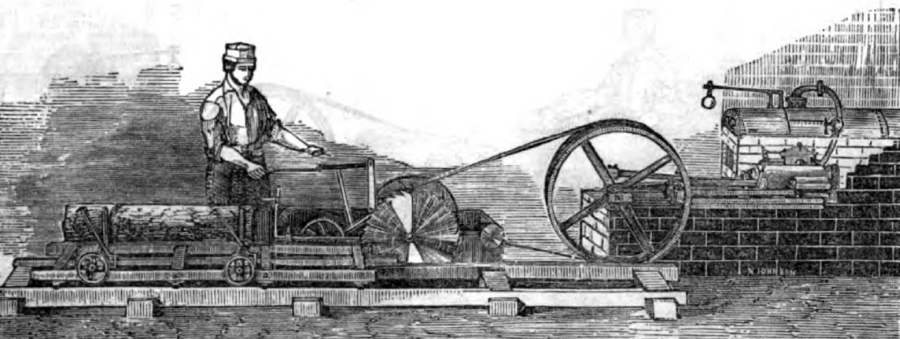 I wrote last week about an early steam engine installed at the Washington Navy Yard. Today, we’ll look at a newer, better one. – ad the man who designed it.
I wrote last week about an early steam engine installed at the Washington Navy Yard. Today, we’ll look at a newer, better one. – ad the man who designed it.
A sawmill had been part of the Navy Yard since at least 1810, and it was an improved version of this one that burned in 1814. By 1823, the sawmill operated under steam power. In 1841, George Page, an inventor from Baltimore, patented an improved circular saw mill, claiming a new way of holding and guiding the logs past the saw blade. The Monthly Chronicle of September, 1841, describes it as “remarkable for its simplicity, and for the rapidity of its performance, in proportion to the amount of power required to sustain it in motion.” The article ended up by stating that “one of these mills is in operation at the Navy Yard, at Washington.”
The following year, the Daily Madisonian published a long ad that indicated that one of these – including the steam engine, plus all the bells and whistles – would run over $3,000, or some $70,000 today. Along with the sawmill, Page also built corn and cob cutting machines, timber wheels, sawing and “planeing” machines, threshing and cleaning machines, a portable grist mill, a tobacco press, morticing machines, augers, tenoning machines and corn shellers – as well as wind mills, two of which were apparently already installed in D.C., in such a way that they could be seen in operation from the Capitol.
Page himself would move to D.C. shortly thereafter, building a shipyard at the end of 7th Street, SW. He specialized in building small steam ships. One of them, named after the inventor himself, had a fairly exciting Civil War. Originally built as a transport in 1853, she was taken over the the US Army at the beginning of the war, then almost immediately captured by the Confederates at Acquia Creek. She was then used by the Confederate Navy until damaged in July of that year, and was later destroyed by her crew when they pulled back from the river.

A Page sawmill from an old catalog (Google Books)
Most of the ships built in this time were used for transportation up and down the Potomac, and Page himself ran a ferry service from his 7th Street wharf. In spite of all of this effort, he found the time to be elected to the city council, representing the 7th Ward.
The Civil War ended all this activity, and Page moved back to Baltimore, where he died in 1873. His obituary in the Evening Star stated that
he possessed great energy, and through his ingenuity produced many machines, which he lived to see put into practical operation, and which have added very materially to the wealth of the country; among them the morticing machine, turning machine, envelope machine, and the circular saw mill. The latter was his greatest achievement and to its development and success the energies of his later business were almost exclusively devoted.
Page’s body was returned to D.C. and he was interred in the Page family vault at Congressional Cemetery.
